Influences of Health and Social Care on NHS Organization
VerifiedAdded on 2023/04/04
|12
|3168
|153
Report
AI Summary
This report examines the influences on health and social care organizations, focusing on the National Health Service (NHS) in England. It explores the impact of organizational structure and culture, leadership effectiveness, and behavioral theories on service delivery. The report analyzes different organizational structures within the NHS, including public and private sectors, and non-profit organizations. It delves into organizational culture, including power, task, and person cultures. The report also discusses the application of behavioral theories, such as the Health Belief Model, and self-efficacy theories, in understanding individual and group behavior within health and social care settings. Furthermore, it investigates how organizational structure and culture affect service delivery, emphasizing the role of leadership in ensuring effective management and client satisfaction. The report highlights the importance of leadership in resource allocation and decision-making, emphasizing the need for leaders to motivate employees and meet societal needs. The report concludes by summarizing the key findings and implications for health and social care organizations.
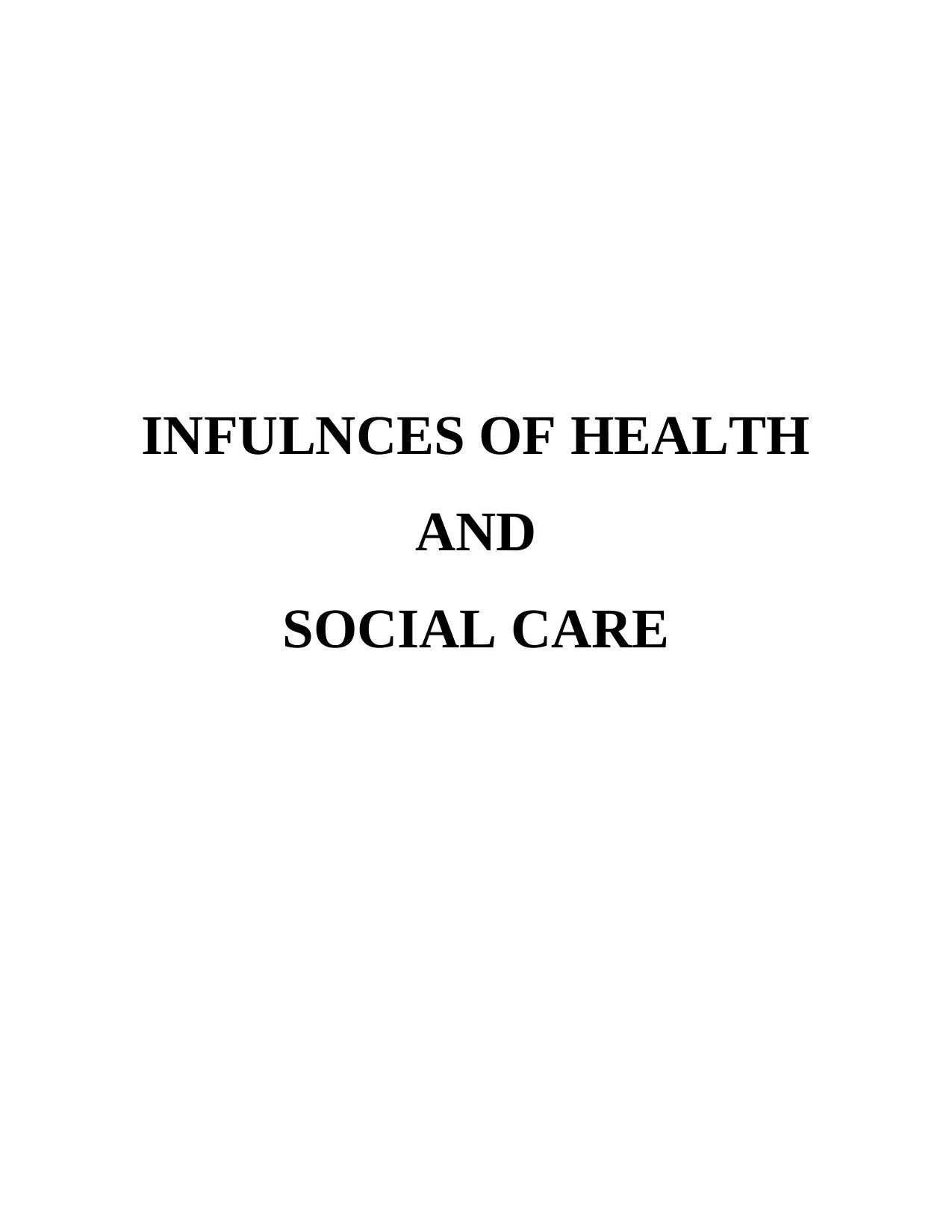
INFULNCES OF HEALTH
AND
SOCIAL CARE
AND
SOCIAL CARE
Paraphrase This Document
Need a fresh take? Get an instant paraphrase of this document with our AI Paraphraser
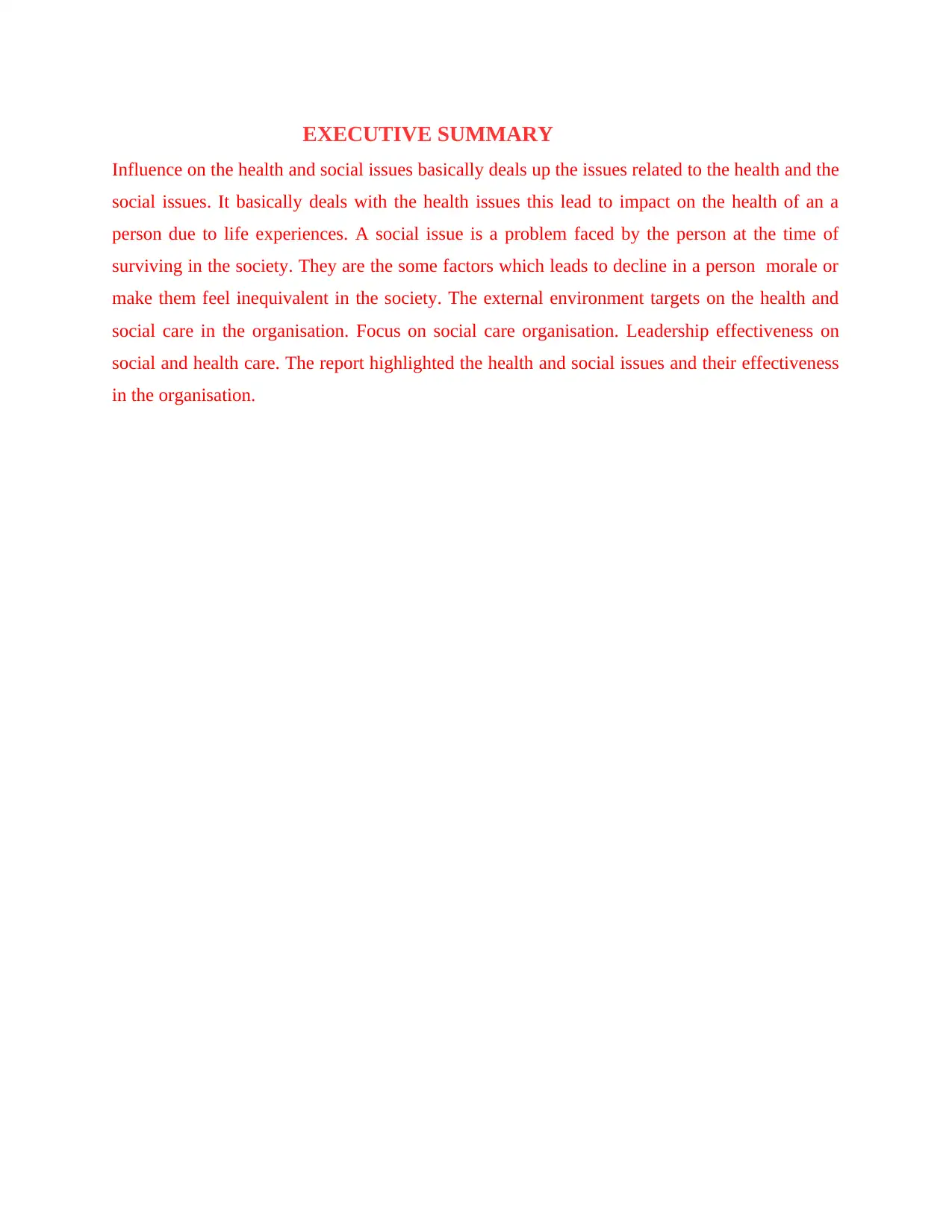
EXECUTIVE SUMMARY
Influence on the health and social issues basically deals up the issues related to the health and the
social issues. It basically deals with the health issues this lead to impact on the health of an a
person due to life experiences. A social issue is a problem faced by the person at the time of
surviving in the society. They are the some factors which leads to decline in a person morale or
make them feel inequivalent in the society. The external environment targets on the health and
social care in the organisation. Focus on social care organisation. Leadership effectiveness on
social and health care. The report highlighted the health and social issues and their effectiveness
in the organisation.
Influence on the health and social issues basically deals up the issues related to the health and the
social issues. It basically deals with the health issues this lead to impact on the health of an a
person due to life experiences. A social issue is a problem faced by the person at the time of
surviving in the society. They are the some factors which leads to decline in a person morale or
make them feel inequivalent in the society. The external environment targets on the health and
social care in the organisation. Focus on social care organisation. Leadership effectiveness on
social and health care. The report highlighted the health and social issues and their effectiveness
in the organisation.
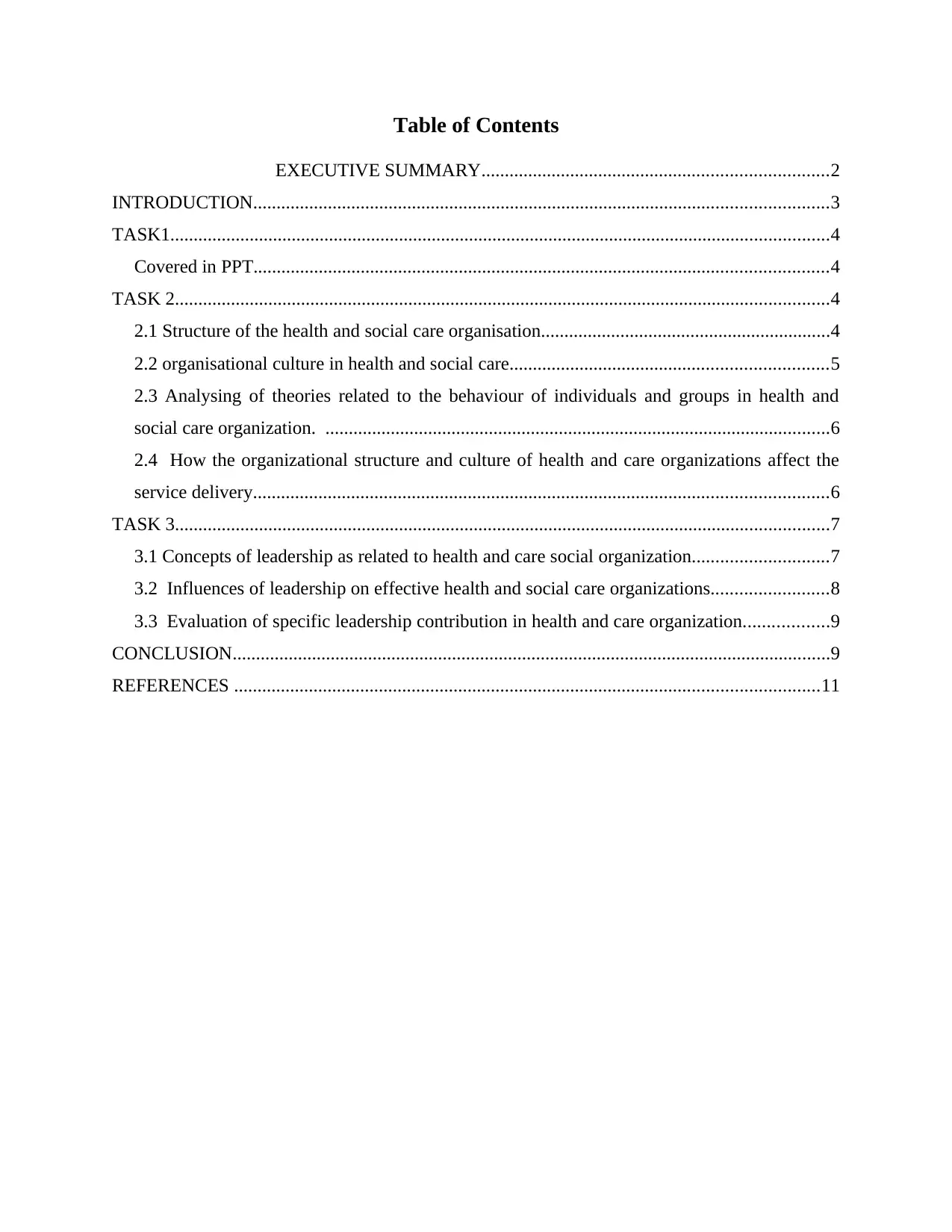
Table of Contents
EXECUTIVE SUMMARY..........................................................................2
INTRODUCTION...........................................................................................................................3
TASK1.............................................................................................................................................4
Covered in PPT...........................................................................................................................4
TASK 2............................................................................................................................................4
2.1 Structure of the health and social care organisation..............................................................4
2.2 organisational culture in health and social care....................................................................5
2.3 Analysing of theories related to the behaviour of individuals and groups in health and
social care organization. ............................................................................................................6
2.4 How the organizational structure and culture of health and care organizations affect the
service delivery...........................................................................................................................6
TASK 3............................................................................................................................................7
3.1 Concepts of leadership as related to health and care social organization.............................7
3.2 Influences of leadership on effective health and social care organizations.........................8
3.3 Evaluation of specific leadership contribution in health and care organization..................9
CONCLUSION................................................................................................................................9
REFERENCES .............................................................................................................................11
EXECUTIVE SUMMARY..........................................................................2
INTRODUCTION...........................................................................................................................3
TASK1.............................................................................................................................................4
Covered in PPT...........................................................................................................................4
TASK 2............................................................................................................................................4
2.1 Structure of the health and social care organisation..............................................................4
2.2 organisational culture in health and social care....................................................................5
2.3 Analysing of theories related to the behaviour of individuals and groups in health and
social care organization. ............................................................................................................6
2.4 How the organizational structure and culture of health and care organizations affect the
service delivery...........................................................................................................................6
TASK 3............................................................................................................................................7
3.1 Concepts of leadership as related to health and care social organization.............................7
3.2 Influences of leadership on effective health and social care organizations.........................8
3.3 Evaluation of specific leadership contribution in health and care organization..................9
CONCLUSION................................................................................................................................9
REFERENCES .............................................................................................................................11
⊘ This is a preview!⊘
Do you want full access?
Subscribe today to unlock all pages.

Trusted by 1+ million students worldwide
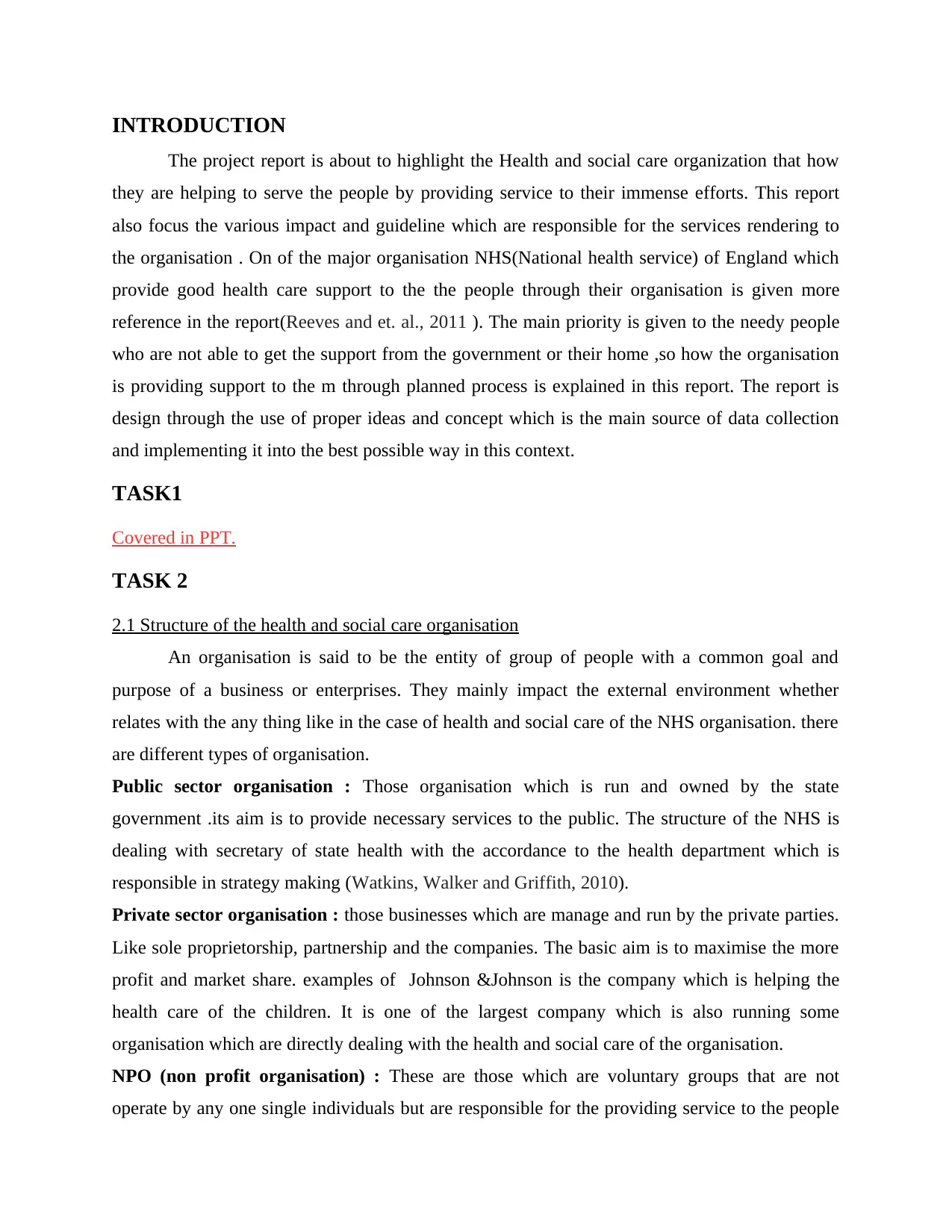
INTRODUCTION
The project report is about to highlight the Health and social care organization that how
they are helping to serve the people by providing service to their immense efforts. This report
also focus the various impact and guideline which are responsible for the services rendering to
the organisation . On of the major organisation NHS(National health service) of England which
provide good health care support to the the people through their organisation is given more
reference in the report(Reeves and et. al., 2011 ). The main priority is given to the needy people
who are not able to get the support from the government or their home ,so how the organisation
is providing support to the m through planned process is explained in this report. The report is
design through the use of proper ideas and concept which is the main source of data collection
and implementing it into the best possible way in this context.
TASK1
Covered in PPT.
TASK 2
2.1 Structure of the health and social care organisation
An organisation is said to be the entity of group of people with a common goal and
purpose of a business or enterprises. They mainly impact the external environment whether
relates with the any thing like in the case of health and social care of the NHS organisation. there
are different types of organisation.
Public sector organisation : Those organisation which is run and owned by the state
government .its aim is to provide necessary services to the public. The structure of the NHS is
dealing with secretary of state health with the accordance to the health department which is
responsible in strategy making (Watkins, Walker and Griffith, 2010).
Private sector organisation : those businesses which are manage and run by the private parties.
Like sole proprietorship, partnership and the companies. The basic aim is to maximise the more
profit and market share. examples of Johnson &Johnson is the company which is helping the
health care of the children. It is one of the largest company which is also running some
organisation which are directly dealing with the health and social care of the organisation.
NPO (non profit organisation) : These are those which are voluntary groups that are not
operate by any one single individuals but are responsible for the providing service to the people
The project report is about to highlight the Health and social care organization that how
they are helping to serve the people by providing service to their immense efforts. This report
also focus the various impact and guideline which are responsible for the services rendering to
the organisation . On of the major organisation NHS(National health service) of England which
provide good health care support to the the people through their organisation is given more
reference in the report(Reeves and et. al., 2011 ). The main priority is given to the needy people
who are not able to get the support from the government or their home ,so how the organisation
is providing support to the m through planned process is explained in this report. The report is
design through the use of proper ideas and concept which is the main source of data collection
and implementing it into the best possible way in this context.
TASK1
Covered in PPT.
TASK 2
2.1 Structure of the health and social care organisation
An organisation is said to be the entity of group of people with a common goal and
purpose of a business or enterprises. They mainly impact the external environment whether
relates with the any thing like in the case of health and social care of the NHS organisation. there
are different types of organisation.
Public sector organisation : Those organisation which is run and owned by the state
government .its aim is to provide necessary services to the public. The structure of the NHS is
dealing with secretary of state health with the accordance to the health department which is
responsible in strategy making (Watkins, Walker and Griffith, 2010).
Private sector organisation : those businesses which are manage and run by the private parties.
Like sole proprietorship, partnership and the companies. The basic aim is to maximise the more
profit and market share. examples of Johnson &Johnson is the company which is helping the
health care of the children. It is one of the largest company which is also running some
organisation which are directly dealing with the health and social care of the organisation.
NPO (non profit organisation) : These are those which are voluntary groups that are not
operate by any one single individuals but are responsible for the providing service to the people
Paraphrase This Document
Need a fresh take? Get an instant paraphrase of this document with our AI Paraphraser
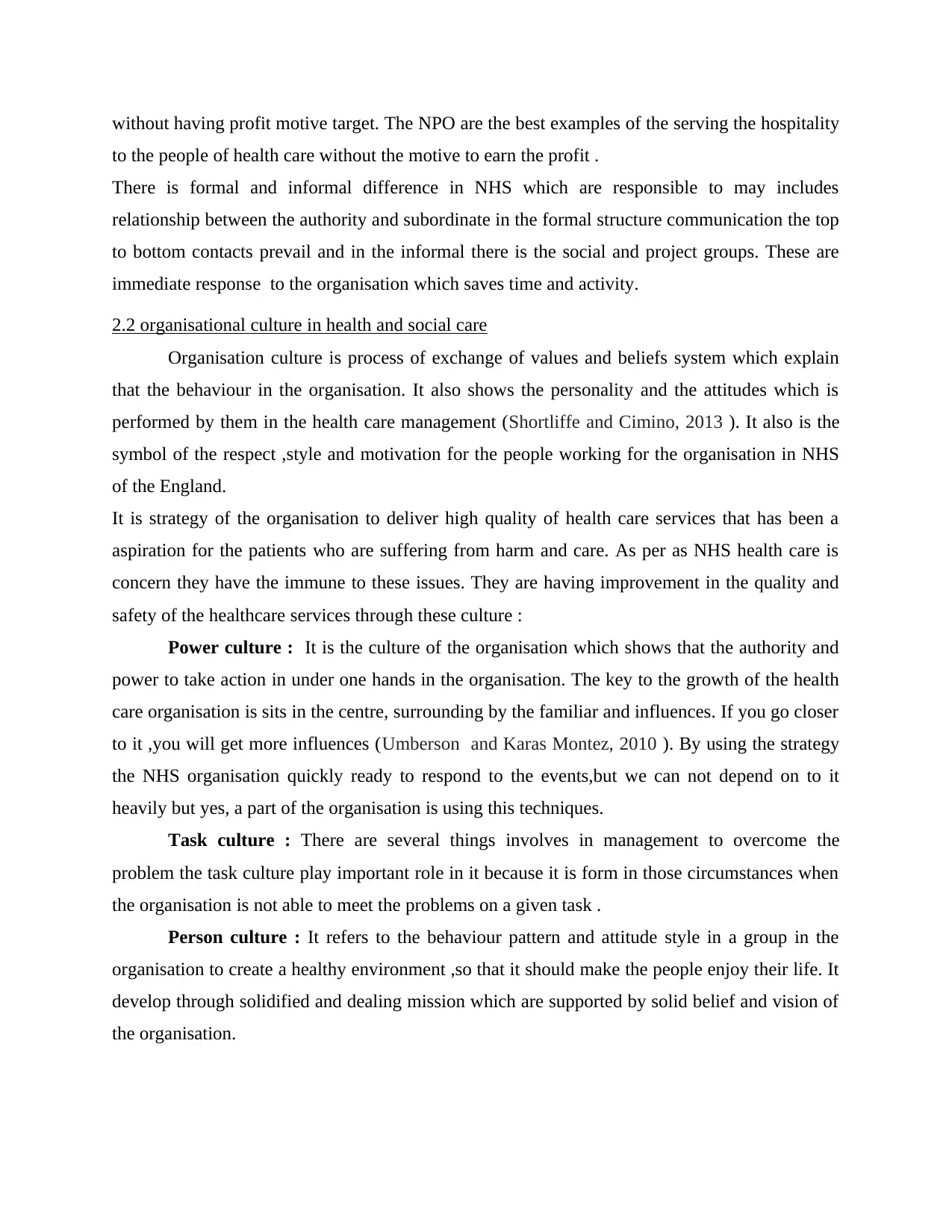
without having profit motive target. The NPO are the best examples of the serving the hospitality
to the people of health care without the motive to earn the profit .
There is formal and informal difference in NHS which are responsible to may includes
relationship between the authority and subordinate in the formal structure communication the top
to bottom contacts prevail and in the informal there is the social and project groups. These are
immediate response to the organisation which saves time and activity.
2.2 organisational culture in health and social care
Organisation culture is process of exchange of values and beliefs system which explain
that the behaviour in the organisation. It also shows the personality and the attitudes which is
performed by them in the health care management (Shortliffe and Cimino, 2013 ). It also is the
symbol of the respect ,style and motivation for the people working for the organisation in NHS
of the England.
It is strategy of the organisation to deliver high quality of health care services that has been a
aspiration for the patients who are suffering from harm and care. As per as NHS health care is
concern they have the immune to these issues. They are having improvement in the quality and
safety of the healthcare services through these culture :
Power culture : It is the culture of the organisation which shows that the authority and
power to take action in under one hands in the organisation. The key to the growth of the health
care organisation is sits in the centre, surrounding by the familiar and influences. If you go closer
to it ,you will get more influences (Umberson and Karas Montez, 2010 ). By using the strategy
the NHS organisation quickly ready to respond to the events,but we can not depend on to it
heavily but yes, a part of the organisation is using this techniques.
Task culture : There are several things involves in management to overcome the
problem the task culture play important role in it because it is form in those circumstances when
the organisation is not able to meet the problems on a given task .
Person culture : It refers to the behaviour pattern and attitude style in a group in the
organisation to create a healthy environment ,so that it should make the people enjoy their life. It
develop through solidified and dealing mission which are supported by solid belief and vision of
the organisation.
to the people of health care without the motive to earn the profit .
There is formal and informal difference in NHS which are responsible to may includes
relationship between the authority and subordinate in the formal structure communication the top
to bottom contacts prevail and in the informal there is the social and project groups. These are
immediate response to the organisation which saves time and activity.
2.2 organisational culture in health and social care
Organisation culture is process of exchange of values and beliefs system which explain
that the behaviour in the organisation. It also shows the personality and the attitudes which is
performed by them in the health care management (Shortliffe and Cimino, 2013 ). It also is the
symbol of the respect ,style and motivation for the people working for the organisation in NHS
of the England.
It is strategy of the organisation to deliver high quality of health care services that has been a
aspiration for the patients who are suffering from harm and care. As per as NHS health care is
concern they have the immune to these issues. They are having improvement in the quality and
safety of the healthcare services through these culture :
Power culture : It is the culture of the organisation which shows that the authority and
power to take action in under one hands in the organisation. The key to the growth of the health
care organisation is sits in the centre, surrounding by the familiar and influences. If you go closer
to it ,you will get more influences (Umberson and Karas Montez, 2010 ). By using the strategy
the NHS organisation quickly ready to respond to the events,but we can not depend on to it
heavily but yes, a part of the organisation is using this techniques.
Task culture : There are several things involves in management to overcome the
problem the task culture play important role in it because it is form in those circumstances when
the organisation is not able to meet the problems on a given task .
Person culture : It refers to the behaviour pattern and attitude style in a group in the
organisation to create a healthy environment ,so that it should make the people enjoy their life. It
develop through solidified and dealing mission which are supported by solid belief and vision of
the organisation.
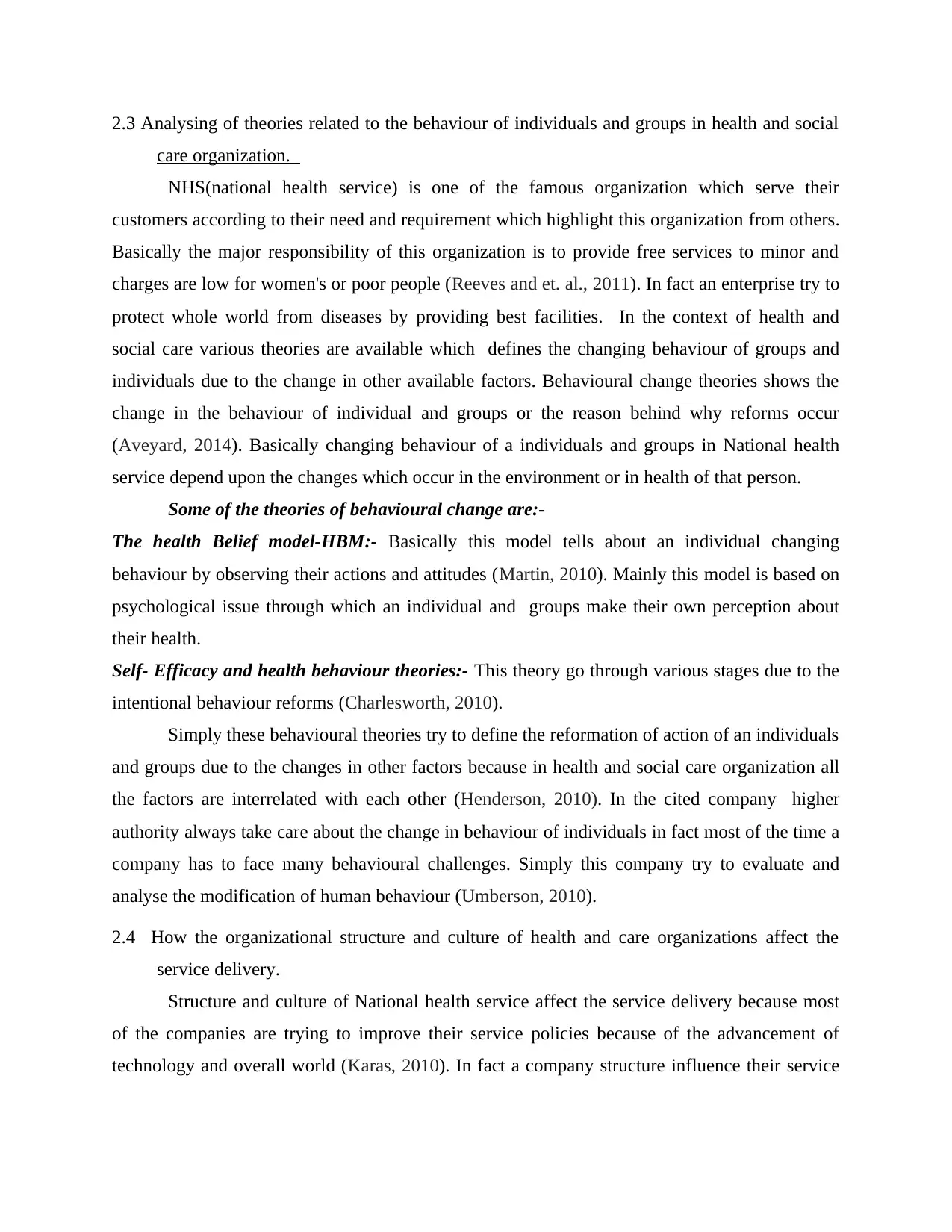
2.3 Analysing of theories related to the behaviour of individuals and groups in health and social
care organization.
NHS(national health service) is one of the famous organization which serve their
customers according to their need and requirement which highlight this organization from others.
Basically the major responsibility of this organization is to provide free services to minor and
charges are low for women's or poor people (Reeves and et. al., 2011). In fact an enterprise try to
protect whole world from diseases by providing best facilities. In the context of health and
social care various theories are available which defines the changing behaviour of groups and
individuals due to the change in other available factors. Behavioural change theories shows the
change in the behaviour of individual and groups or the reason behind why reforms occur
(Aveyard, 2014). Basically changing behaviour of a individuals and groups in National health
service depend upon the changes which occur in the environment or in health of that person.
Some of the theories of behavioural change are:-
The health Belief model-HBM:- Basically this model tells about an individual changing
behaviour by observing their actions and attitudes (Martin, 2010). Mainly this model is based on
psychological issue through which an individual and groups make their own perception about
their health.
Self- Efficacy and health behaviour theories:- This theory go through various stages due to the
intentional behaviour reforms (Charlesworth, 2010).
Simply these behavioural theories try to define the reformation of action of an individuals
and groups due to the changes in other factors because in health and social care organization all
the factors are interrelated with each other (Henderson, 2010). In the cited company higher
authority always take care about the change in behaviour of individuals in fact most of the time a
company has to face many behavioural challenges. Simply this company try to evaluate and
analyse the modification of human behaviour (Umberson, 2010).
2.4 How the organizational structure and culture of health and care organizations affect the
service delivery.
Structure and culture of National health service affect the service delivery because most
of the companies are trying to improve their service policies because of the advancement of
technology and overall world (Karas, 2010). In fact a company structure influence their service
care organization.
NHS(national health service) is one of the famous organization which serve their
customers according to their need and requirement which highlight this organization from others.
Basically the major responsibility of this organization is to provide free services to minor and
charges are low for women's or poor people (Reeves and et. al., 2011). In fact an enterprise try to
protect whole world from diseases by providing best facilities. In the context of health and
social care various theories are available which defines the changing behaviour of groups and
individuals due to the change in other available factors. Behavioural change theories shows the
change in the behaviour of individual and groups or the reason behind why reforms occur
(Aveyard, 2014). Basically changing behaviour of a individuals and groups in National health
service depend upon the changes which occur in the environment or in health of that person.
Some of the theories of behavioural change are:-
The health Belief model-HBM:- Basically this model tells about an individual changing
behaviour by observing their actions and attitudes (Martin, 2010). Mainly this model is based on
psychological issue through which an individual and groups make their own perception about
their health.
Self- Efficacy and health behaviour theories:- This theory go through various stages due to the
intentional behaviour reforms (Charlesworth, 2010).
Simply these behavioural theories try to define the reformation of action of an individuals
and groups due to the changes in other factors because in health and social care organization all
the factors are interrelated with each other (Henderson, 2010). In the cited company higher
authority always take care about the change in behaviour of individuals in fact most of the time a
company has to face many behavioural challenges. Simply this company try to evaluate and
analyse the modification of human behaviour (Umberson, 2010).
2.4 How the organizational structure and culture of health and care organizations affect the
service delivery.
Structure and culture of National health service affect the service delivery because most
of the companies are trying to improve their service policies because of the advancement of
technology and overall world (Karas, 2010). In fact a company structure influence their service
⊘ This is a preview!⊘
Do you want full access?
Subscribe today to unlock all pages.

Trusted by 1+ million students worldwide
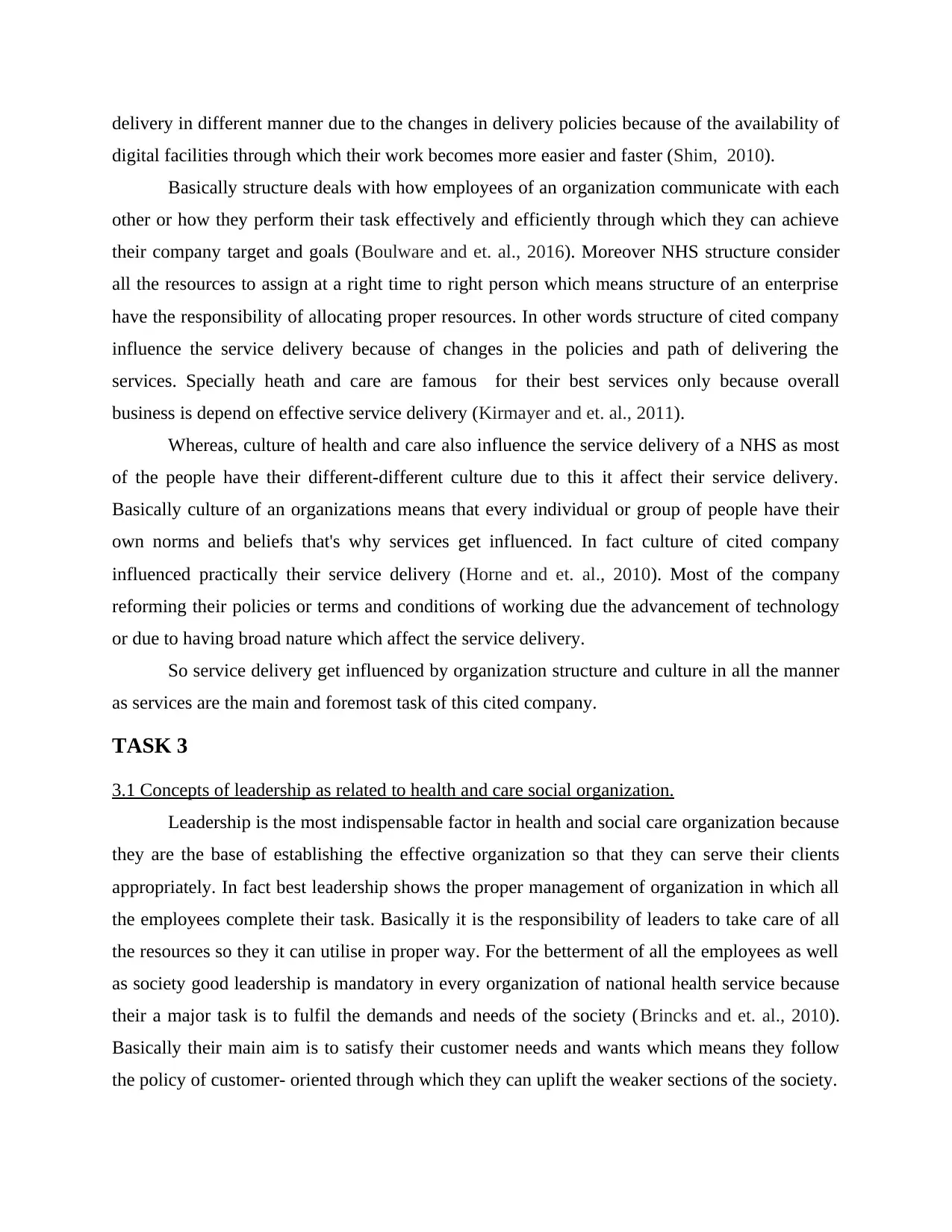
delivery in different manner due to the changes in delivery policies because of the availability of
digital facilities through which their work becomes more easier and faster (Shim, 2010).
Basically structure deals with how employees of an organization communicate with each
other or how they perform their task effectively and efficiently through which they can achieve
their company target and goals (Boulware and et. al., 2016). Moreover NHS structure consider
all the resources to assign at a right time to right person which means structure of an enterprise
have the responsibility of allocating proper resources. In other words structure of cited company
influence the service delivery because of changes in the policies and path of delivering the
services. Specially heath and care are famous for their best services only because overall
business is depend on effective service delivery (Kirmayer and et. al., 2011).
Whereas, culture of health and care also influence the service delivery of a NHS as most
of the people have their different-different culture due to this it affect their service delivery.
Basically culture of an organizations means that every individual or group of people have their
own norms and beliefs that's why services get influenced. In fact culture of cited company
influenced practically their service delivery (Horne and et. al., 2010). Most of the company
reforming their policies or terms and conditions of working due the advancement of technology
or due to having broad nature which affect the service delivery.
So service delivery get influenced by organization structure and culture in all the manner
as services are the main and foremost task of this cited company.
TASK 3
3.1 Concepts of leadership as related to health and care social organization.
Leadership is the most indispensable factor in health and social care organization because
they are the base of establishing the effective organization so that they can serve their clients
appropriately. In fact best leadership shows the proper management of organization in which all
the employees complete their task. Basically it is the responsibility of leaders to take care of all
the resources so they it can utilise in proper way. For the betterment of all the employees as well
as society good leadership is mandatory in every organization of national health service because
their a major task is to fulfil the demands and needs of the society (Brincks and et. al., 2010).
Basically their main aim is to satisfy their customer needs and wants which means they follow
the policy of customer- oriented through which they can uplift the weaker sections of the society.
digital facilities through which their work becomes more easier and faster (Shim, 2010).
Basically structure deals with how employees of an organization communicate with each
other or how they perform their task effectively and efficiently through which they can achieve
their company target and goals (Boulware and et. al., 2016). Moreover NHS structure consider
all the resources to assign at a right time to right person which means structure of an enterprise
have the responsibility of allocating proper resources. In other words structure of cited company
influence the service delivery because of changes in the policies and path of delivering the
services. Specially heath and care are famous for their best services only because overall
business is depend on effective service delivery (Kirmayer and et. al., 2011).
Whereas, culture of health and care also influence the service delivery of a NHS as most
of the people have their different-different culture due to this it affect their service delivery.
Basically culture of an organizations means that every individual or group of people have their
own norms and beliefs that's why services get influenced. In fact culture of cited company
influenced practically their service delivery (Horne and et. al., 2010). Most of the company
reforming their policies or terms and conditions of working due the advancement of technology
or due to having broad nature which affect the service delivery.
So service delivery get influenced by organization structure and culture in all the manner
as services are the main and foremost task of this cited company.
TASK 3
3.1 Concepts of leadership as related to health and care social organization.
Leadership is the most indispensable factor in health and social care organization because
they are the base of establishing the effective organization so that they can serve their clients
appropriately. In fact best leadership shows the proper management of organization in which all
the employees complete their task. Basically it is the responsibility of leaders to take care of all
the resources so they it can utilise in proper way. For the betterment of all the employees as well
as society good leadership is mandatory in every organization of national health service because
their a major task is to fulfil the demands and needs of the society (Brincks and et. al., 2010).
Basically their main aim is to satisfy their customer needs and wants which means they follow
the policy of customer- oriented through which they can uplift the weaker sections of the society.
Paraphrase This Document
Need a fresh take? Get an instant paraphrase of this document with our AI Paraphraser
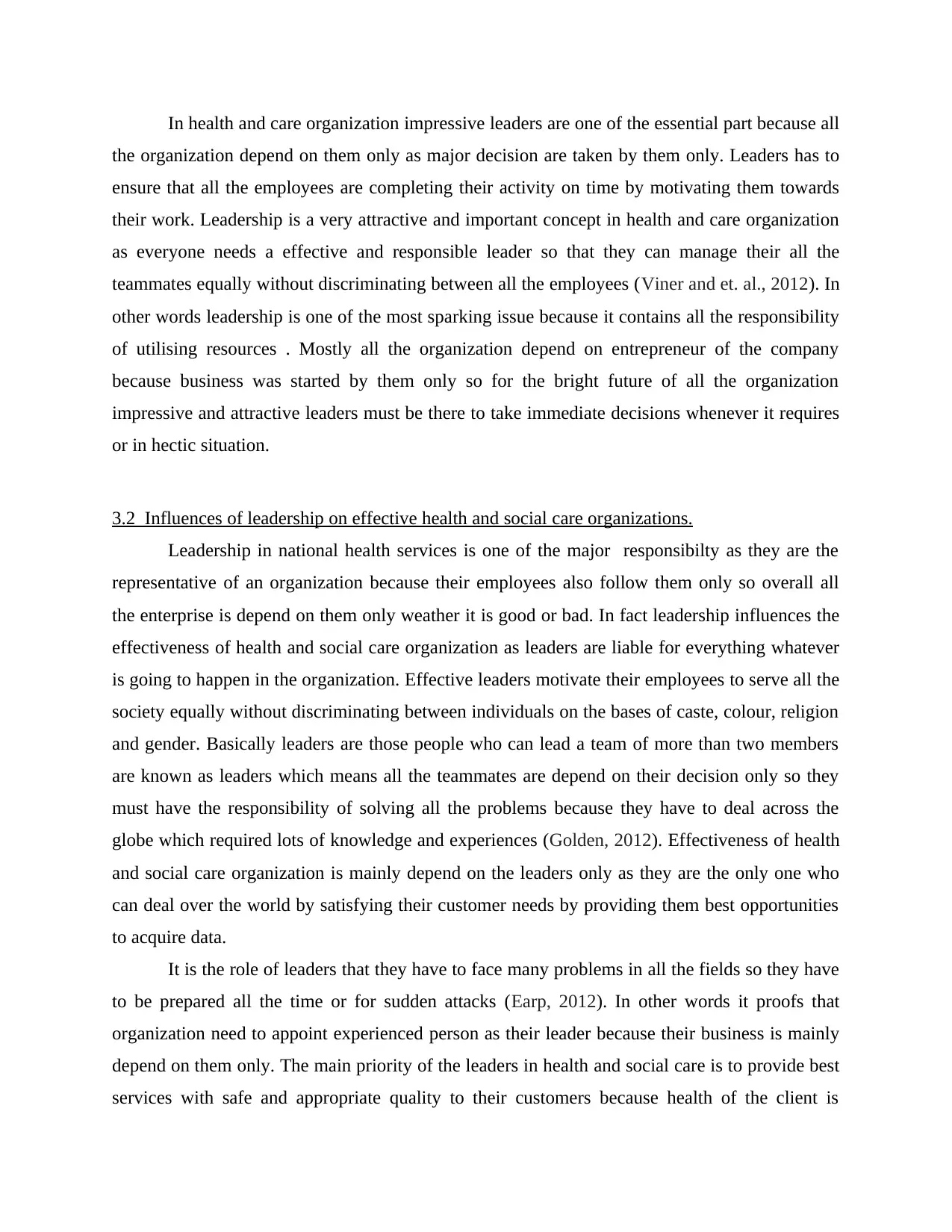
In health and care organization impressive leaders are one of the essential part because all
the organization depend on them only as major decision are taken by them only. Leaders has to
ensure that all the employees are completing their activity on time by motivating them towards
their work. Leadership is a very attractive and important concept in health and care organization
as everyone needs a effective and responsible leader so that they can manage their all the
teammates equally without discriminating between all the employees (Viner and et. al., 2012). In
other words leadership is one of the most sparking issue because it contains all the responsibility
of utilising resources . Mostly all the organization depend on entrepreneur of the company
because business was started by them only so for the bright future of all the organization
impressive and attractive leaders must be there to take immediate decisions whenever it requires
or in hectic situation.
3.2 Influences of leadership on effective health and social care organizations.
Leadership in national health services is one of the major responsibilty as they are the
representative of an organization because their employees also follow them only so overall all
the enterprise is depend on them only weather it is good or bad. In fact leadership influences the
effectiveness of health and social care organization as leaders are liable for everything whatever
is going to happen in the organization. Effective leaders motivate their employees to serve all the
society equally without discriminating between individuals on the bases of caste, colour, religion
and gender. Basically leaders are those people who can lead a team of more than two members
are known as leaders which means all the teammates are depend on their decision only so they
must have the responsibility of solving all the problems because they have to deal across the
globe which required lots of knowledge and experiences (Golden, 2012). Effectiveness of health
and social care organization is mainly depend on the leaders only as they are the only one who
can deal over the world by satisfying their customer needs by providing them best opportunities
to acquire data.
It is the role of leaders that they have to face many problems in all the fields so they have
to be prepared all the time or for sudden attacks (Earp, 2012). In other words it proofs that
organization need to appoint experienced person as their leader because their business is mainly
depend on them only. The main priority of the leaders in health and social care is to provide best
services with safe and appropriate quality to their customers because health of the client is
the organization depend on them only as major decision are taken by them only. Leaders has to
ensure that all the employees are completing their activity on time by motivating them towards
their work. Leadership is a very attractive and important concept in health and care organization
as everyone needs a effective and responsible leader so that they can manage their all the
teammates equally without discriminating between all the employees (Viner and et. al., 2012). In
other words leadership is one of the most sparking issue because it contains all the responsibility
of utilising resources . Mostly all the organization depend on entrepreneur of the company
because business was started by them only so for the bright future of all the organization
impressive and attractive leaders must be there to take immediate decisions whenever it requires
or in hectic situation.
3.2 Influences of leadership on effective health and social care organizations.
Leadership in national health services is one of the major responsibilty as they are the
representative of an organization because their employees also follow them only so overall all
the enterprise is depend on them only weather it is good or bad. In fact leadership influences the
effectiveness of health and social care organization as leaders are liable for everything whatever
is going to happen in the organization. Effective leaders motivate their employees to serve all the
society equally without discriminating between individuals on the bases of caste, colour, religion
and gender. Basically leaders are those people who can lead a team of more than two members
are known as leaders which means all the teammates are depend on their decision only so they
must have the responsibility of solving all the problems because they have to deal across the
globe which required lots of knowledge and experiences (Golden, 2012). Effectiveness of health
and social care organization is mainly depend on the leaders only as they are the only one who
can deal over the world by satisfying their customer needs by providing them best opportunities
to acquire data.
It is the role of leaders that they have to face many problems in all the fields so they have
to be prepared all the time or for sudden attacks (Earp, 2012). In other words it proofs that
organization need to appoint experienced person as their leader because their business is mainly
depend on them only. The main priority of the leaders in health and social care is to provide best
services with safe and appropriate quality to their customers because health of the client is
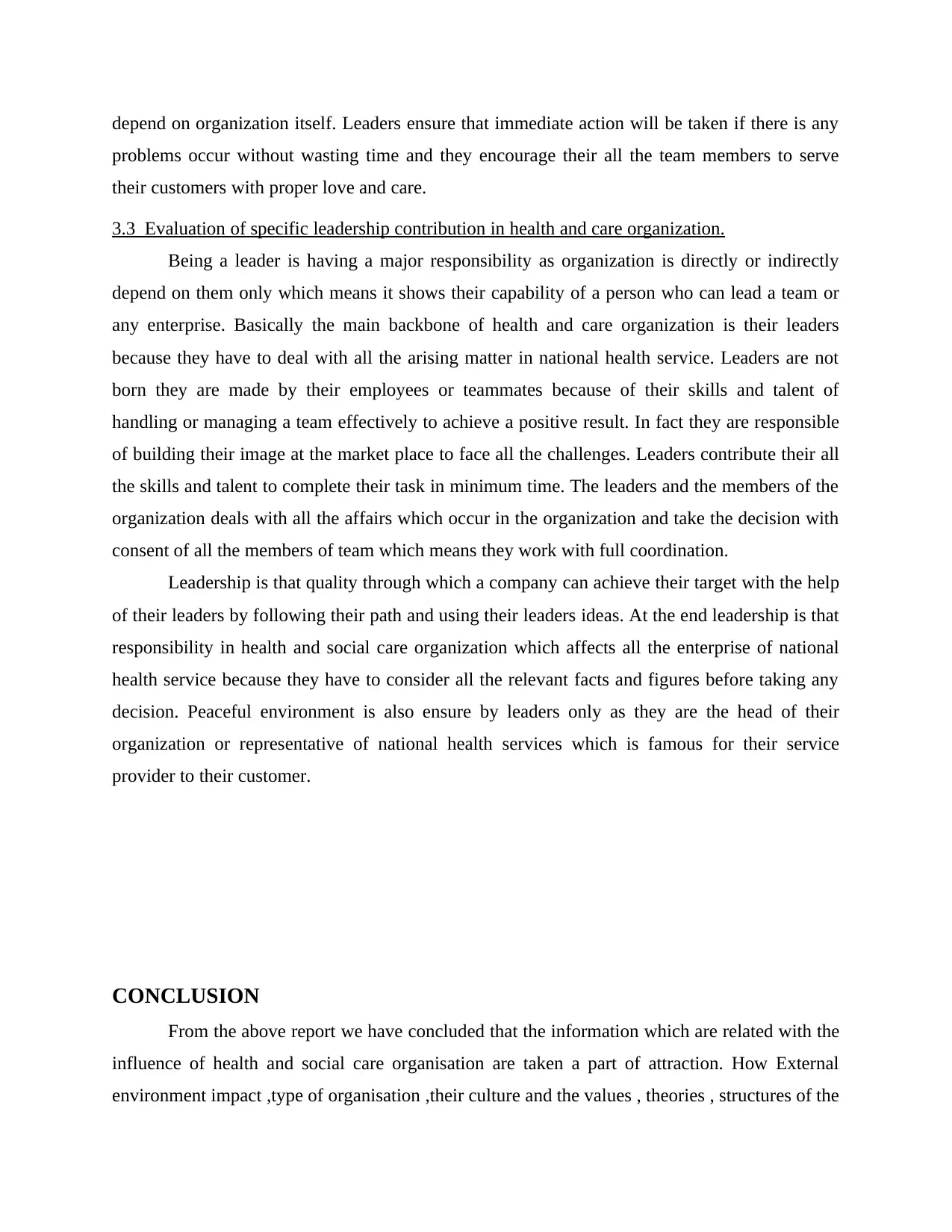
depend on organization itself. Leaders ensure that immediate action will be taken if there is any
problems occur without wasting time and they encourage their all the team members to serve
their customers with proper love and care.
3.3 Evaluation of specific leadership contribution in health and care organization.
Being a leader is having a major responsibility as organization is directly or indirectly
depend on them only which means it shows their capability of a person who can lead a team or
any enterprise. Basically the main backbone of health and care organization is their leaders
because they have to deal with all the arising matter in national health service. Leaders are not
born they are made by their employees or teammates because of their skills and talent of
handling or managing a team effectively to achieve a positive result. In fact they are responsible
of building their image at the market place to face all the challenges. Leaders contribute their all
the skills and talent to complete their task in minimum time. The leaders and the members of the
organization deals with all the affairs which occur in the organization and take the decision with
consent of all the members of team which means they work with full coordination.
Leadership is that quality through which a company can achieve their target with the help
of their leaders by following their path and using their leaders ideas. At the end leadership is that
responsibility in health and social care organization which affects all the enterprise of national
health service because they have to consider all the relevant facts and figures before taking any
decision. Peaceful environment is also ensure by leaders only as they are the head of their
organization or representative of national health services which is famous for their service
provider to their customer.
CONCLUSION
From the above report we have concluded that the information which are related with the
influence of health and social care organisation are taken a part of attraction. How External
environment impact ,type of organisation ,their culture and the values , theories , structures of the
problems occur without wasting time and they encourage their all the team members to serve
their customers with proper love and care.
3.3 Evaluation of specific leadership contribution in health and care organization.
Being a leader is having a major responsibility as organization is directly or indirectly
depend on them only which means it shows their capability of a person who can lead a team or
any enterprise. Basically the main backbone of health and care organization is their leaders
because they have to deal with all the arising matter in national health service. Leaders are not
born they are made by their employees or teammates because of their skills and talent of
handling or managing a team effectively to achieve a positive result. In fact they are responsible
of building their image at the market place to face all the challenges. Leaders contribute their all
the skills and talent to complete their task in minimum time. The leaders and the members of the
organization deals with all the affairs which occur in the organization and take the decision with
consent of all the members of team which means they work with full coordination.
Leadership is that quality through which a company can achieve their target with the help
of their leaders by following their path and using their leaders ideas. At the end leadership is that
responsibility in health and social care organization which affects all the enterprise of national
health service because they have to consider all the relevant facts and figures before taking any
decision. Peaceful environment is also ensure by leaders only as they are the head of their
organization or representative of national health services which is famous for their service
provider to their customer.
CONCLUSION
From the above report we have concluded that the information which are related with the
influence of health and social care organisation are taken a part of attraction. How External
environment impact ,type of organisation ,their culture and the values , theories , structures of the
⊘ This is a preview!⊘
Do you want full access?
Subscribe today to unlock all pages.

Trusted by 1+ million students worldwide
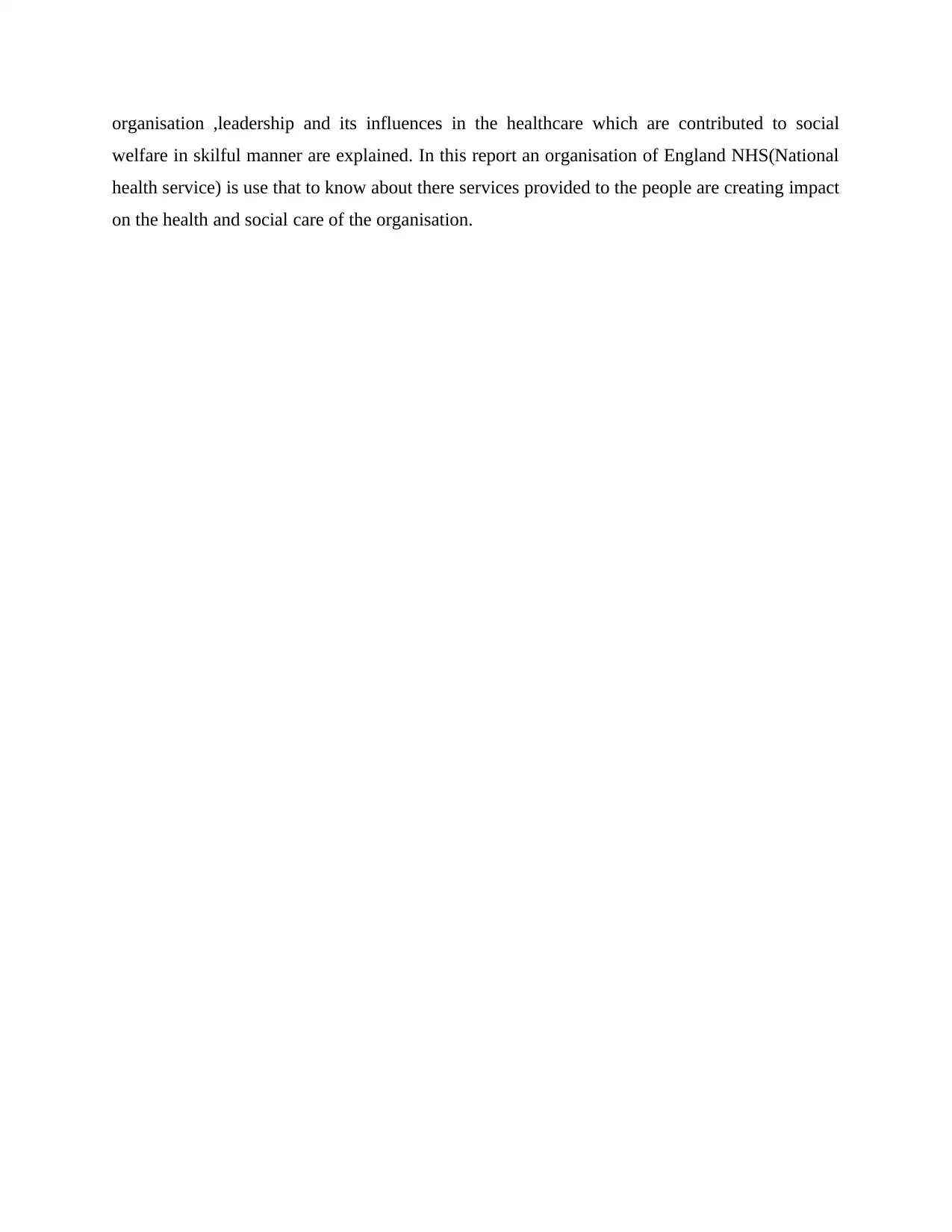
organisation ,leadership and its influences in the healthcare which are contributed to social
welfare in skilful manner are explained. In this report an organisation of England NHS(National
health service) is use that to know about there services provided to the people are creating impact
on the health and social care of the organisation.
welfare in skilful manner are explained. In this report an organisation of England NHS(National
health service) is use that to know about there services provided to the people are creating impact
on the health and social care of the organisation.
Paraphrase This Document
Need a fresh take? Get an instant paraphrase of this document with our AI Paraphraser
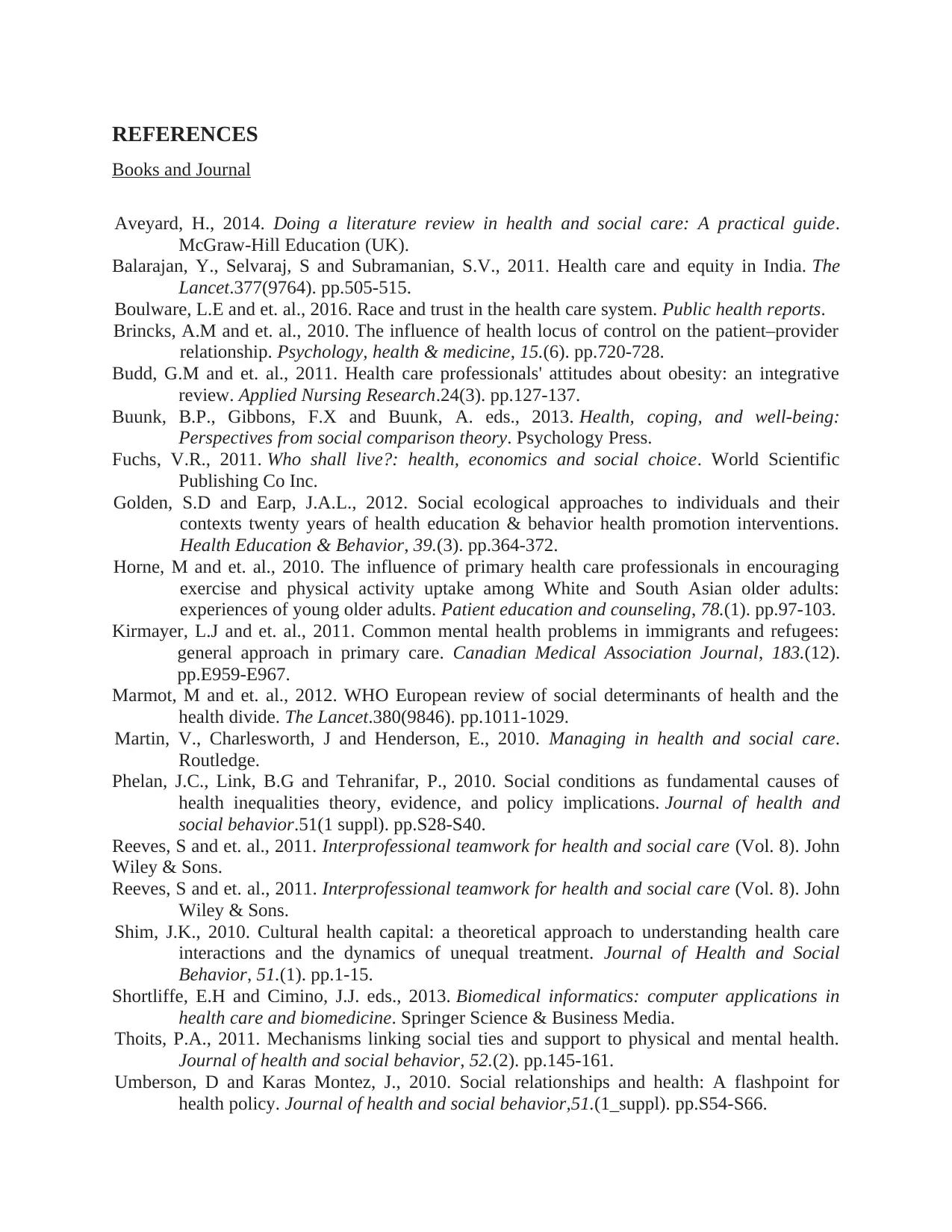
REFERENCES
Books and Journal
Aveyard, H., 2014. Doing a literature review in health and social care: A practical guide.
McGraw-Hill Education (UK).
Balarajan, Y., Selvaraj, S and Subramanian, S.V., 2011. Health care and equity in India. The
Lancet.377(9764). pp.505-515.
Boulware, L.E and et. al., 2016. Race and trust in the health care system. Public health reports.
Brincks, A.M and et. al., 2010. The influence of health locus of control on the patient–provider
relationship. Psychology, health & medicine, 15.(6). pp.720-728.
Budd, G.M and et. al., 2011. Health care professionals' attitudes about obesity: an integrative
review. Applied Nursing Research.24(3). pp.127-137.
Buunk, B.P., Gibbons, F.X and Buunk, A. eds., 2013. Health, coping, and well-being:
Perspectives from social comparison theory. Psychology Press.
Fuchs, V.R., 2011. Who shall live?: health, economics and social choice. World Scientific
Publishing Co Inc.
Golden, S.D and Earp, J.A.L., 2012. Social ecological approaches to individuals and their
contexts twenty years of health education & behavior health promotion interventions.
Health Education & Behavior, 39.(3). pp.364-372.
Horne, M and et. al., 2010. The influence of primary health care professionals in encouraging
exercise and physical activity uptake among White and South Asian older adults:
experiences of young older adults. Patient education and counseling, 78.(1). pp.97-103.
Kirmayer, L.J and et. al., 2011. Common mental health problems in immigrants and refugees:
general approach in primary care. Canadian Medical Association Journal, 183.(12).
pp.E959-E967.
Marmot, M and et. al., 2012. WHO European review of social determinants of health and the
health divide. The Lancet.380(9846). pp.1011-1029.
Martin, V., Charlesworth, J and Henderson, E., 2010. Managing in health and social care.
Routledge.
Phelan, J.C., Link, B.G and Tehranifar, P., 2010. Social conditions as fundamental causes of
health inequalities theory, evidence, and policy implications. Journal of health and
social behavior.51(1 suppl). pp.S28-S40.
Reeves, S and et. al., 2011. Interprofessional teamwork for health and social care (Vol. 8). John
Wiley & Sons.
Reeves, S and et. al., 2011. Interprofessional teamwork for health and social care (Vol. 8). John
Wiley & Sons.
Shim, J.K., 2010. Cultural health capital: a theoretical approach to understanding health care
interactions and the dynamics of unequal treatment. Journal of Health and Social
Behavior, 51.(1). pp.1-15.
Shortliffe, E.H and Cimino, J.J. eds., 2013. Biomedical informatics: computer applications in
health care and biomedicine. Springer Science & Business Media.
Thoits, P.A., 2011. Mechanisms linking social ties and support to physical and mental health.
Journal of health and social behavior, 52.(2). pp.145-161.
Umberson, D and Karas Montez, J., 2010. Social relationships and health: A flashpoint for
health policy. Journal of health and social behavior,51.(1_suppl). pp.S54-S66.
Books and Journal
Aveyard, H., 2014. Doing a literature review in health and social care: A practical guide.
McGraw-Hill Education (UK).
Balarajan, Y., Selvaraj, S and Subramanian, S.V., 2011. Health care and equity in India. The
Lancet.377(9764). pp.505-515.
Boulware, L.E and et. al., 2016. Race and trust in the health care system. Public health reports.
Brincks, A.M and et. al., 2010. The influence of health locus of control on the patient–provider
relationship. Psychology, health & medicine, 15.(6). pp.720-728.
Budd, G.M and et. al., 2011. Health care professionals' attitudes about obesity: an integrative
review. Applied Nursing Research.24(3). pp.127-137.
Buunk, B.P., Gibbons, F.X and Buunk, A. eds., 2013. Health, coping, and well-being:
Perspectives from social comparison theory. Psychology Press.
Fuchs, V.R., 2011. Who shall live?: health, economics and social choice. World Scientific
Publishing Co Inc.
Golden, S.D and Earp, J.A.L., 2012. Social ecological approaches to individuals and their
contexts twenty years of health education & behavior health promotion interventions.
Health Education & Behavior, 39.(3). pp.364-372.
Horne, M and et. al., 2010. The influence of primary health care professionals in encouraging
exercise and physical activity uptake among White and South Asian older adults:
experiences of young older adults. Patient education and counseling, 78.(1). pp.97-103.
Kirmayer, L.J and et. al., 2011. Common mental health problems in immigrants and refugees:
general approach in primary care. Canadian Medical Association Journal, 183.(12).
pp.E959-E967.
Marmot, M and et. al., 2012. WHO European review of social determinants of health and the
health divide. The Lancet.380(9846). pp.1011-1029.
Martin, V., Charlesworth, J and Henderson, E., 2010. Managing in health and social care.
Routledge.
Phelan, J.C., Link, B.G and Tehranifar, P., 2010. Social conditions as fundamental causes of
health inequalities theory, evidence, and policy implications. Journal of health and
social behavior.51(1 suppl). pp.S28-S40.
Reeves, S and et. al., 2011. Interprofessional teamwork for health and social care (Vol. 8). John
Wiley & Sons.
Reeves, S and et. al., 2011. Interprofessional teamwork for health and social care (Vol. 8). John
Wiley & Sons.
Shim, J.K., 2010. Cultural health capital: a theoretical approach to understanding health care
interactions and the dynamics of unequal treatment. Journal of Health and Social
Behavior, 51.(1). pp.1-15.
Shortliffe, E.H and Cimino, J.J. eds., 2013. Biomedical informatics: computer applications in
health care and biomedicine. Springer Science & Business Media.
Thoits, P.A., 2011. Mechanisms linking social ties and support to physical and mental health.
Journal of health and social behavior, 52.(2). pp.145-161.
Umberson, D and Karas Montez, J., 2010. Social relationships and health: A flashpoint for
health policy. Journal of health and social behavior,51.(1_suppl). pp.S54-S66.

Umberson, D and Karas Montez, J., 2010. Social relationships and health: A flashpoint for health
policy. Journal of health and social behavior.51(1_suppl). pp.S54-S66.
Viner, R.M and et. al., 2012. Adolescence and the social determinants of health. The lancet, 379.
(9826). pp.1641-1652.
Watkins, D.C., Walker, R.L. and Griffith, D.M., 2010. A meta-study of Black male mental health
and well-being. Journal of black psychology.36(3). pp.303-330.
policy. Journal of health and social behavior.51(1_suppl). pp.S54-S66.
Viner, R.M and et. al., 2012. Adolescence and the social determinants of health. The lancet, 379.
(9826). pp.1641-1652.
Watkins, D.C., Walker, R.L. and Griffith, D.M., 2010. A meta-study of Black male mental health
and well-being. Journal of black psychology.36(3). pp.303-330.
⊘ This is a preview!⊘
Do you want full access?
Subscribe today to unlock all pages.

Trusted by 1+ million students worldwide
1 out of 12
Related Documents
Your All-in-One AI-Powered Toolkit for Academic Success.
+13062052269
info@desklib.com
Available 24*7 on WhatsApp / Email
![[object Object]](/_next/static/media/star-bottom.7253800d.svg)
Unlock your academic potential
Copyright © 2020–2025 A2Z Services. All Rights Reserved. Developed and managed by ZUCOL.





